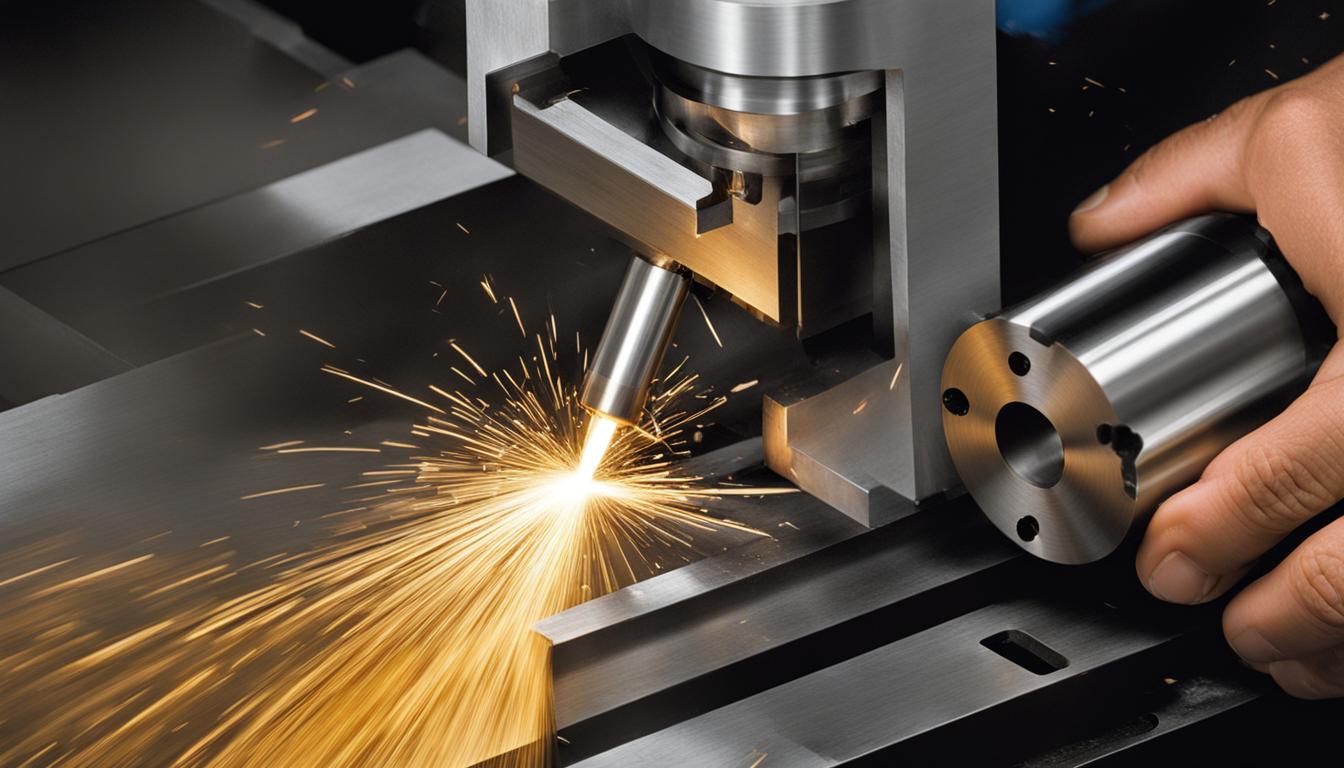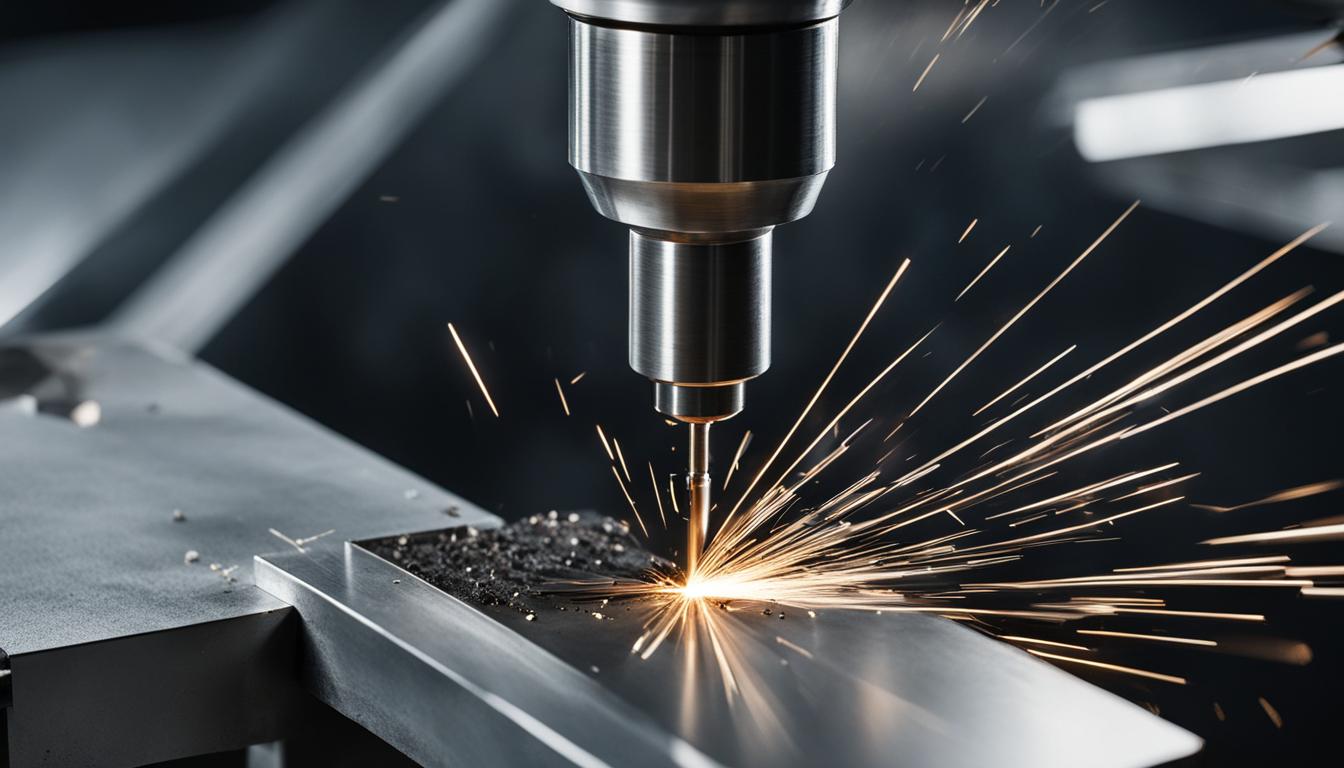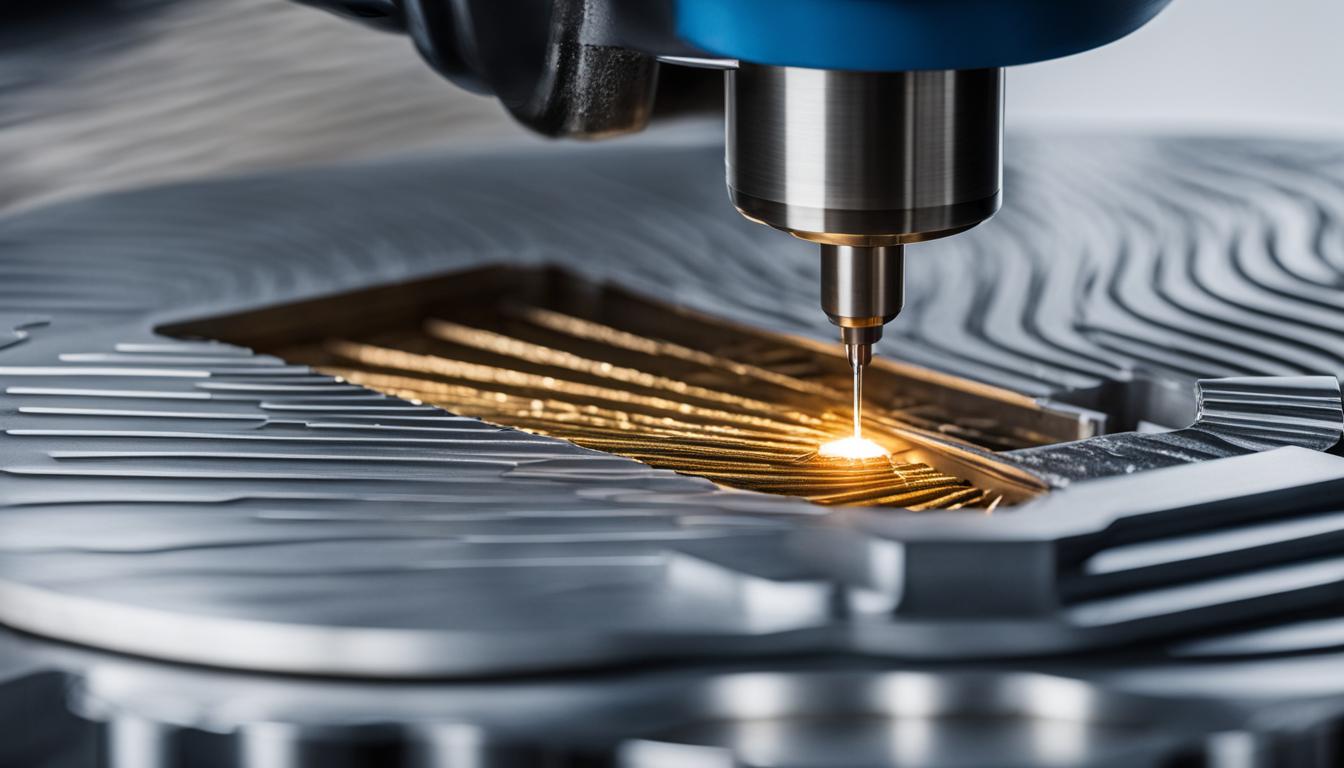Milling is a widely used machining process that involves the use of rotating cutting tools to remove material from a workpiece. There are several types of milling techniques and processes, each with its own specific purpose and advantages. Understanding these different types of milling can help you choose the right one for your specific manufacturing needs.
Key Takeaways
- There are various types of milling techniques and processes available.
- Face milling is commonly used for producing flat surfaces and precision finishes on large workpieces.
- Slot milling is commonly used for creating slots, grooves, and keyways in components.
- End milling is versatile and can be used for creating slots, pockets, and contours.
- Thread milling is used to cut precise internal and external threads in a workpiece.
Face Milling
Face milling is a milling procedure used for removing material from the flat end face of a workpiece. It involves the use of a face mill, a cutting tool with a flat end surface, to remove material by plunge cutting or traversing across the workpiece. Face milling is commonly used for producing flat surfaces, achieving precise and smooth finishes, and working on large workpieces like engine blocks and metal plates.
| Advantages of Face Milling | Applications of Face Milling |
|---|---|
|
|
By utilizing face milling techniques, manufacturers can remove material efficiently from flat surfaces, achieving precision finishes and working on large workpieces. The process involves using specialized cutting tools to remove material from the end face of the workpiece, resulting in flat and smooth surfaces.
Whether it’s the production of engine blocks, the creation of precision finishes on metal plates, or the machining of components that require high accuracy and flatness, face milling is a versatile and effective technique in modern manufacturing.
Slot Milling
Slot milling is a milling process that is commonly used to create slots, grooves, and keyways in a workpiece. This technique involves the use of specialized cutting tools such as slotting cutters or end mills to remove material and form slots of various shapes and sizes.
Slot milling is a versatile method that finds applications in various industries, including automotive, aerospace, and manufacturing. It allows for the precise creation of slots and channels, enabling the integration of key features in components.
One of the key advantages of slot milling is the ability to produce keyways, which are narrow slots that provide a seating area for keys or other mechanical components. Keyways are crucial in shafts and hubs, providing secure connections and efficient power transmission.
Grooves are another feature that can be easily created through slot milling. These grooves serve various purposes, such as guiding parts or accommodating seals and O-rings. They play a critical role in ensuring proper functionality and assembly of mechanical components.
The slotting cutter or end mill used in slot milling is designed to remove material efficiently and precisely. It features sharp cutting edges and a robust construction to withstand the demands of slotting operations.
End Milling
End milling is a versatile milling process that allows for the creation of various features such as slots, pockets, and contours on the surface of a workpiece. This technique involves removing material using the flat end of an end mill, a type of cutting tool specifically designed for this purpose.
End milling is commonly used in manufacturing operations where precise and intricate features are required. It is particularly effective for creating slots, which are narrow, elongated openings in the workpiece. These slots can serve multiple purposes, such as accommodating fasteners, guiding components, or facilitating the flow of fluids or gases.
Additionally, end milling can be utilized to create pockets, which are recessed areas in the workpiece. Pockets are commonly used for housing components, providing clearance for other parts, or simply reducing the weight of the workpiece.
Furthermore, end milling enables the formation of contours on the surface of the workpiece. Contours are curved or irregularly shaped features that add aesthetic appeal or functional characteristics to the final product.
Advantages of End Milling
- Allows for the creation of precise slots, pockets, and contours.
- Offers versatility for a wide range of milling operations.
- Can be used on various materials, including metals, plastics, and composites.
- Enables efficient material removal, resulting in faster production times.
- Provides excellent surface finish and dimensional accuracy.
End Milling Examples
Here are a few examples of how end milling can be applied in different industries:
| Industry | Application |
|---|---|
| Automotive | Creating slots and pockets for engine components |
| Aerospace | Producing contours on aircraft parts |
| Electronics | Machining slots for circuit boards |
| Woodworking | Forming decorative contours on furniture |

Thread Milling
Thread milling is a milling process used to cut threads in a workpiece. It offers a versatile and efficient method for creating both internal and external threads. Thread milling involves the use of specialized cutting tools that are similar to taps or dies, depending on the type of thread needed.
Unlike traditional thread-cutting methods, such as tapping and die-cutting, thread milling allows for greater flexibility in thread design and precision. It enables the creation of precise and complex thread profiles, including customized thread forms and pitches. This makes thread milling particularly useful in manufacturing applications that require high-quality threads with tight tolerances.
Internal threads, which are used to screw fasteners into a workpiece, can be easily created using thread milling. The process involves plunging the cutting tool into the workpiece to remove material and form the internal threads. The cutting tool moves in a helical path, gradually cutting the threads to the desired depth and shape.
External threads, on the other hand, are produced by moving the workpiece relative to the cutting tool. This allows the cutting tool to traverse along the workpiece, removing material and forming the external threads. Thread milling can create threads of various diameters and pitches, making it suitable for a wide range of applications.
Shoulder Milling
Shoulder milling is a machining process that involves removing material from the shoulder or sidewall of a workpiece. It is a versatile technique used in the manufacturing industry to create precise shoulders and step features in components. The process utilizes a milling cutter with multiple inserts or cutting edges to achieve efficient material removal.
Shoulder milling is commonly employed to create flat or contoured surfaces on workpieces, offering flexibility in design and functionality. It allows for the production of smooth and uniform shoulders, enhancing the overall quality and appearance of the final product.
The primary advantage of shoulder milling is its ability to remove large amounts of material quickly and efficiently. By using multiple inserts or cutting edges, the process can achieve high productivity and reduce machining time.
Furthermore, shoulder milling can be utilized on various materials, including metals, plastics, and composites, making it suitable for a wide range of manufacturing applications.

Advantages of Shoulder Milling:
- Efficient removal of material from the shoulder or sidewall
- Ability to create flat or contoured surfaces
- Multiple inserts or cutting edges for increased productivity
- Suitable for various materials
- Precise production of shoulders and step features
Side Milling
Side milling is a machining process that involves removing material from the side of a workpiece using a cutting tool such as an end mill or side milling cutter. This process is commonly used in various manufacturing applications to create flat or contoured surfaces, slots, grooves, and pockets on the side of a workpiece. Side milling allows for the production of complex shapes and features with precision and efficiency.
Side milling is suitable for machining both flat and contoured surfaces, making it versatile for a wide range of applications. Whether you need to create a simple slot or a more intricate pocket, side milling offers the flexibility to achieve the desired outcome.
One of the key advantages of side milling is its ability to remove material efficiently and accurately. The cutting tool used in side milling, such as an end mill or side milling cutter, features multiple cutting edges that help in achieving a smooth and precise finish. This makes side milling an ideal choice for tasks that require high precision and quality.
In summary, side milling is a machining process that offers the capability to create flat or contoured surfaces, slots, grooves, and pockets on the side of a workpiece. With the right cutting tool and proper techniques, side milling allows for the production of complex shapes and features with precision and efficiency.
Profile Milling
Profile milling is a milling process used to create complex shapes, contours, or profiles on the surface of a workpiece. It involves the use of a specialized cutting tool with multiple cutting edges, often with a ball tip, to follow a programmed path and remove material.
This technique is particularly useful for manufacturing parts with intricate designs and unique surface geometries. By utilizing profile milling, manufacturers can produce molds, dies, and components with precision and versatility. The ability to create complex shapes and contours allows for the production of intricate and customized parts.
Profile milling is commonly employed in industries such as aerospace, automotive, and medical manufacturing, where the production of highly detailed and specific components is required. By utilizing multiple axes and a specialized cutting tool, profile milling enables manufacturers to achieve the desired level of intricacy and accuracy in their workpieces.
Whether it’s creating organic curves, intricate profiles, or complex geometric shapes, profile milling offers the flexibility and precision necessary for producing high-quality parts. With its ability to handle various materials and accommodate different design requirements, profile milling is an indispensable technique in modern manufacturing processes.
Gear Milling
Gear milling is a milling process used to produce gears or gear teeth on workpieces. It plays a crucial role in industries like automotive and machinery manufacturing, where precise gearing and high-precision tooth profiles are essential for smooth power transmission and motion control.
The gear milling process involves the use of specialized cutting tools like gear hobbing cutters or gear milling cutters. These tools are designed to remove material and form the gear teeth with accuracy and precision.
CNC (Computer Numerical Control) and manual machines are commonly used for high-precision gear milling operations. These machines offer the capability to create various types of gears, including spur gears, helical gears, and bevel gears.
Advantages of Gear Milling:
- Precision: Gear milling enables the production of high-precision tooth profiles, ensuring smooth and efficient gear operation.
- Versatility: With the use of different cutting tools, gear milling can create various types of gears suitable for different applications.
- Efficiency: Gear milling allows for the manufacturing of gears with precise tooth spacing and alignment, resulting in efficient power transmission.
- Flexibility: CNC machines offer the flexibility to produce gears of different sizes and designs, meeting specific manufacturing requirements.
Application of Gear Milling:
Gears produced through the gear milling process are widely used in various industries, including:
- Automotive: Gears are essential components in automotive transmissions, engines, and drivetrain systems.
- Machinery: Gears are crucial for power transmission and motion control in machinery, such as milling machines, lathes, and industrial equipment.
- Aerospace: Gears are used in aircraft engines, landing gear systems, and other aerospace applications.
- Power Generation: Gears play a vital role in wind turbines, hydroelectric generators, and other power generation systems.
Overall, gear milling is a fundamental process in the manufacturing industry, enabling the production of precise and high-quality gears for various applications.
Angle Milling
Angle milling is a versatile milling process that allows for the creation of beveled edges, chamfers, and angled features on a workpiece. By using specialized tapered milling cutters or parallel-faced cutters, this technique can be performed on a tilting arbor or a 4+ axis machine, enabling precise machining of angled surfaces and edges.
One of the key advantages of angle milling is its ability to add unique design elements to components. Beveled edges and chamfers not only enhance the aesthetic appeal of a workpiece but also provide functional benefits such as improved edge strength and easier assembly. Angled features, on the other hand, can be used to create complex contours and profiles, allowing for the production of intricate and visually appealing designs.
By utilizing tapered milling cutters, angle milling offers greater control and precision in achieving desired angles. The tilting arbor or a 4+ axis machine further enhances the flexibility and range of angles that can be achieved, making it ideal for a wide range of applications in industries such as aerospace, automotive, and architectural design.
